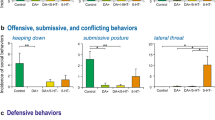Abstract
Thirty-two male albino rats were trained on a black-white discrimination for water reward. Forty-eight hours later, half were tested for memory of the task and the other half trained on a reversal. Subjects received α-methyltyrosine (α-MT), an inhibitor of catecholamine (CA) biosynthesis, by multiple i.p. injections of 50 mg/kg, before the training session, before the testing or reversal, before both, or before neither. Data analysis showed that drugged rats learned the black-white discrimination in fewer trials (p<0.0005), but had longer latencies (p<0.0005). These data are contrasted to α-MT depression of the conditioned avoidance response (CAR), and the difference attributed to the role of CA in motor ability and in attention.
Similar content being viewed by others
References
Ahlenius, S., Anden, N., Engel, J.: Importance of catecholamine release by nerve impulse for free operant behavior. Physiol. Behav. 7, 931–934 (1971).
Arbuthnott, G., Fuxe, K., Ungerstedt, U.: Central catecholamine turnover and self-stimulation behaviour. Brain Res. 27, 406–413 (1971).
Bertler, A., Rosengren, E.: Occurrence and distribution of catecholamines in brain. Acta physiol. scand. 47, 356–361 (1959).
Black, W., Cooper, B.: Reduction of electrically-rewarded behavior by interference with monoamine synthesis. Physiol. Behav. 5, 1405–1409 (1970).
Chan, O., Webster, R. A.: Importance of noradrenaline found in a functional pool on maintaining spontaneous locomotor activity in rats. Brit. J. Pharmacol. 41, 700–708 (1971).
Fuster, J. M.: Excitation and inhibition of neuronal firing in visual cortex by reticular stimulation. Science 133, 2011–2012 (1961).
Grice, G. R.: The relation of secondary reinforcement to delayed reward in visual discrimination learning. J. exp. Psychol. 38, 1–16 (1948).
Hanson, L. C. F.: The disruption of conditioned avoidance response following selective depletion of brain catecholamines. Psychopharmacologia (Berl.) 8, 100–110 (1965).
Hanson, L. C. F.: Biochemical and behavioral effects of tyrosine hydroxylase inhibition. Psychopharmacologia (Berl.) 11, 8–17 (1967).
Houser, V. P.: The effects of adrenergic and cholinergic agents upon eating and drinking in deprived rats. Psychonomic. Sci. Sect. Anim. Physiol. Psychol. 20, 153–155 (1970).
Larochelle, L., Bédard, P., Poirier, L. J., Sourkes, T. L.: Correlative neuroanatomical and neuropharmacological study of tremor and catatonia in the monkey. Neuropharmacology 10, 273–278 (1971).
Miller, F. P., Cox, R. H., Maickel, R. P.: The effects of altered brain norepinephrine levels on continuous avoidance responding and the action of amphetamines. Neuropharmacology 9, 511–517 (1970).
Moore, K. E.: Effects of alpha-methyltyrosine on brain catecholamines and conditioned behavior in guinea pigs. Life Sci. 5, 55–65 (1966).
Rech, R. H., Borys, H. K., Moore, K. E.: Alterations in behavior and brain catecholamine levels in rats treated with alpha-methyltyrosine. J. Pharmacol. exp. Ther. 153, 412–419 (1966).
Redmond, D. E., Maas, J W., Kling, A., Dekirmenjian, H.: Changes in primate social behavior after treatment with alpha-methyltyrosine. Psychosom. Med. 33, 97–113 (1971).
Scheonfeld, R. I., Seiden, L. S.: Effect of alpha-methyltyrosine on operant behavior and brain catecholamine levels. J. Pharmacol. exp. Ther. 167, 319–327 (1969).
Shellenberger, M. K.: Effects of alpha-methyltyrosine on spontaneous and caudate-induced electroencephalographic activity and regional catecholamine concentrations in the cat brain. Neuropharmacology 10, 347–357 (1971).
Spector, S., Sjoerdsma, A., Udenfriend, S.: Blockade of endogenous norepinephrine synthesis by alpha-methyltyrosine, an inhibitor of tyrosine hydroxylase. J. Pharmacol. exp. Ther. 147, 86–95 (1965).
Svensson, T. H., Waldeck, B.: On the role of brain catecholamines in motor activity: Experiments with inhibitors of synthesis and monoamine oxidase. Psychopharmacologia (Berl.) 18, 357–365 (1970).
Svensson, T. H., Waldeck, B.: On the relation between motor activity and the degree of enzyme inhibition following inhibition of tyrosine hydroxylase. Acta Pharmacol. Toxicol. 29, 60–64 (1971).
Sweeney, D. C.: The anatomical distribution of monoamines in a fresh-water bivalve mollusc, Sphaerium sulcatum (L.). Comp. Biochem. Physiol. 25, 601–613 (1968).
Tanaka, C., Yo, Y. J., Takaori, S.: Relationship between brain monoamine levels and Sidman avoidance behavior in rats treated with tyrosine and tryptophan hydroxylase inhibitors. Brain Res. 45, 153–164 (1972).
Tenen, S. S.: The effects of p-chlorophenylalanine, a serotonin depletor, on avoidance acquisition, pain sensitivity, and related behavior in the rat. Psychopharmacologia (Berl.) 10, 204–219 (1967).
Thornburg, J. E., Moore, K. E.: Stress related effects of various inhibitors of catecholamine synthesis in the mouse. Arch. int. Pharmacodyn. 194, 158–167 (1971).
Udenfriend, S., Zaltman-Nirenberg, P., Gordon, R., Spector, S.: Evaluation of the biochemical effects produced in vivo by inhibitors of the three enzymes involved in norepinephrine biosynthesis. Molec. Pharmacol. 2, 95–105 (1966).
Vogt, M.: The concentration of sympathin in different parts of the central nervous system under normal conditions and after the administration of drugs. J. Physiol. (Lond.) 123, 451–460 (1954).
Wada, J. A., Wrinch, J., Hill, D., McGeer, P. L., McGeer, E. G.: Central aromatic amine levels and behavior. Arch. Neurol. (Chic.) 9, 69–89 (1963).
Wise, C. D., Stein, L.: Facilitation of brain self-stimulation by central administration of norepinephrine. Science 163, 299–301 (1969).
Author information
Authors and Affiliations
Rights and permissions
About this article
Cite this article
Saper, C.B., Sweeney, D.C. Enhanced appetitive discrimination learning in rats treated with α-methyltyrosine. Psychopharmacologia 30, 37–44 (1973). https://doi.org/10.1007/BF00422792
Received:
Revised:
Issue Date:
DOI: https://doi.org/10.1007/BF00422792




